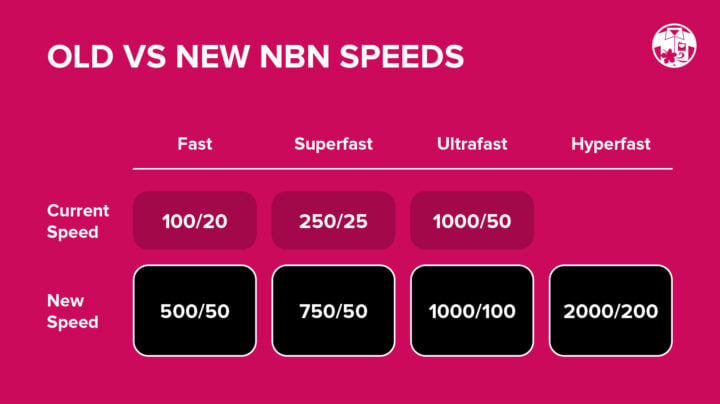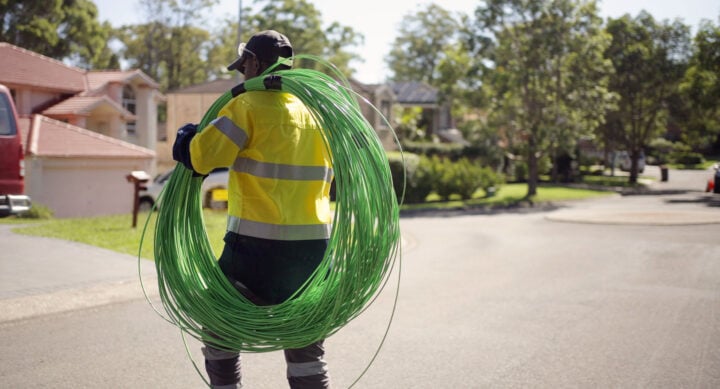I recently asked some friends about the NBN speed upgrade coming in the next few months. They stared at me blankly, as if it was the first they’d heard about it. As it turns out, they hadn’t heard the news. I figured if my reasonably tech-literate mates weren’t in the know, then plenty others might also be in the dark. So, here’s a primer on what’s happening.
The long and short of it is that NBN Co (the company responsible for much of Australia’s internet infrastructure) is increasing the speed of multiple fixed-line internet plans in September 2025. Put on the agenda last year, it planned to boost some connection types with up to five times faster speeds. On top of that, it’s introducing a new “Hyperfast” tier capable of reaching 2,000Mbps.
That’s roughly double the peak speeds of some of Australia’s existing fastest residential NBN plans. Labelled “Accelerate Great“, NBN Co’s project to increase speeds is meant to address Australia’s increasing reliance on internet connectivity.

Research from NBN Co indicates that Australians’ data needs are growing, hence the push for faster speeds. On average, an Australian household has 25 internet-connected devices, which is expected to increase to 44 devices by 2030. That’s expected to contribute to exponentially higher download and upload rates in the next few years.
Not everyone will get the faster speeds, however, and there’s a bit to wrap your head around before September.
Table of contents
- When is the upgrade happening?
- Who is eligible for the NBN speed upgrade?
- What if I don’t have FTTP or HFC?
- How fast is the NBN speed upgrade?
- How much does the NBN speed upgrade cost?
- What hardware do I need?
When is the upgrade happening?
NBN Co previously announced that its faster speeds will be available to “participating internet retailers from 14 September 2025.”
Some telcos have already launched new internet plans ahead of the upgrade. Exetel, owned by Superloop, was one of the first, scrapping all of its plans to instead offer just one option: a 500Mbps plan that lets you pause while on holiday to save money.
Tangerine followed suit, launching a new plan with 500Mbps download speeds. Interestingly, as the fine print states, its fastest plan temporarily uses the NBN’s existing 1000Mbps tier before transitioning to the 500Mbps tier once the speed upgrade kicks in.
For the most part, telcos will supply faster NBN speeds starting on 14 September.
Who is eligible for the NBN speed upgrade?
There are a couple of main eligibility criteria to check before getting too excited about the NBN speed upgrade. To start with, the speed upgrades apply to NBN 100 (Home Fast), NBN 250 (Home Superfast), and NBN 1000 (Home Ultrafast) plans.
You also need to have either a Fibre to the Premises (FTTP) or a Hybrid Fibre Coaxial connection. If you’re not sure what you have, search your address on NBN Co’s website. It will tell you what connection you have, or whether you’re eligible for an upgrade.
What if I don’t have FTTP or HFC?
According to the ACCC’s NBN Wholesale Market Indicators Report, there are more than 2.5 million active FTTP connections and nearly 2 million HFC connections as of March 2025. That still leaves nearly 3.5 million Fibre to the Node and Fibre to the Curb connections that can’t access faster speeds.
NBN Co is still working to make FTTP available to more Australian premises; earlier this year, it pledged to make full fibre available to 95% of the country’s homes and businesses by 2030. It expects that 90% of homes and businesses will have access by the end of 2025.

If you don’t already have FTTP, upgrading is free for many addresses when signing up to an eligible plan. You need to contact an internet provider to confirm this, as costs may enter the equation depending on existing infrastructure.
If a fixed-line connection isn’t possible, there is some good news. Fixed wireless NBN recently got an upgrade, with recent testing reporting download speeds of nearly 300Mbps. 5G internet is also an option, as telcos upgrade their equipment to handle faster speeds.
How fast is the NBN speed upgrade?
In some cases, the upgrade will quintuple existing speeds. NBN 100 plans, or Home Fast, will go from 100Mbps download speeds to 500Mbps. NBN 250, or Home Superfast, will bump up to 750Mbps. Both tiers will also enjoy faster upload rates of up to 50Mbps.
Those on the previous fastest fixed-line NBN technology will get double the upload speeds, going from 50Mbps to 100Mbps, while the 1,000Mbps download speed will remain. For faster download speeds, NBN is launching “Home Hyperfast”, which can reach 2,000Mbps down, and up to 200Mbps up (depending on your connection type).
| NBN plan | Old speeds (download/upload) | New speeds (download/upload) |
|---|---|---|
| Home Fast | 100/20 Mbps | 500/50 Mbps |
| Home Superfast | 250/25 Mbps | 750/50 Mbps |
| Home Ultrafast | 1,000/50 Mbps | 1,000/100 Mbps |
| Home Hyperfast | N/A | 2,000/100 Mbps (HFC) 2,000/200 Mbps (FTTP) |
Compared to existing speeds, it’s a pretty substantial upgrade, especially for people on NBN 100 or NBN 250 plans.
How much does the NBN speed upgrade cost?
Perhaps in the best news of all, the faster speeds come at no extra cost. NBN internet prices recently went up, but it has nothing to do with the speed upgrade. NBN Co revises its prices every financial year based on the Consumer Price Index, which is why costs recently went up.
Multiple telcos confirmed to GadgetGuy that the costs of existing NBN plans will not increase in September as a result of the speed upgrades. Optus also includes a disclaimer on its website confirming that customers on FTTP and HFC will be brought onto eligible faster plans “at no extra cost”.
As mentioned above, upgrading to an FTTP connection is free for many premises. However, some installations might incur a cost, which your telco will communicate to you before proceeding.
It’s also worth noting that not everyone needs faster internet speeds. Roughly 3.6 million Australians are on NBN 50 plans, according to the ACCC’s data, which is enough for pretty much every essential internet task.
Even though the speed upgrades are free to those on eligible plans, the price of moving from a slower plan to a faster tier sits between $5-$10 per month when comparing the cheapest NBN 50 and NBN 100 plans.
Home networking hardware upgrades are another potential cost, which I’ll cover in the next section.
What hardware do I need?
With faster internet speeds around the corner, there are concerns that households’ existing networking gear might be a limitation. As a result, the ACCC updated its industry guidance to ensure that telcos inform customers about what hardware they need.
This mainly concerns modems and routers, the hardware that connects your home to the internet and then to your devices. Most telcos recommend using a Wi-Fi 6 modem and router setup, which is generally fast enough to handle gigabit speeds.
Any networking device that uses Wi-Fi 4 or Wi-Fi 5 technology, however, will struggle to transmit the speeds featured among NBN’s fastest plans. To use a previous example, the $99 D-Link N300 modem router sold by JB Hi-Fi uses Wi-Fi 4 technology. The “300” in its product name indicates a maximum data rate of 300Mbps, which is too slow for the new Home Fast speed of 500Mbps.
You want to make sure any modem or router (or combination) supports both the wired and wireless speeds you want. Some networking gear supports gigabit, or multi-gigabit, speeds via Ethernet, but that doesn’t necessarily mean it can transmit those same speeds wirelessly. A modem or router’s spec sheet should clearly outline its maximum wired and wireless speeds.
Again, upgrading your networking hardware is only required if you plan to use the faster speeds on offer and want the best possible performance. Other factors, like home layout, device compatibility, and neighbouring interference, also impact network quality.
That’s about the long and short of the planned NBN speed upgrade coming in September. We’ll keep you updated with more advice and new information between now and then.








